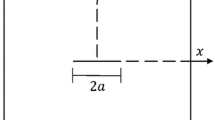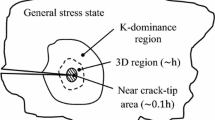Abstract
The external forces method is a numerical method for K calculation based on the finite element method. It uses the work of the external forces W for the calculation of the energy release rate and is particularly advantageous when that forces are applied far from the crack front. The method was applied to a corner crack geometry with the objective of studying its accuracy. Good results were obtained for a wide range of virtual crack displacements (0.03% < Δa/a < 6%) considering 4 values of W along with a polynomial regression of order 3. For that choice of parameters the inaccuracy of K is mainly due to FEM errors. A great sensitivity of K to FEM errors was observed, however accurate values of K were obtained, with errors lower than 2 percent. So, the use of the external forces method for the calculation of K is recommended, considering its simplicity and accuracy.
Similar content being viewed by others
References
Antunes, F.J.V. (1993). Use of Finite Element Method in The Calculation of Stress Intensity Factors, Master Thesis, Department of Mechanical Engineering, University of Coimbra. (In Portuguese)
Bakker, A. (1992). Three-dimensional constraint effects on stress intensity distributions in plate geometries with through-thickness cracks. Fatigue and Fracture of Engineering Materials and Structures 15(11), 1051–1069.
Banks-Sills, L. and Sherman, D. (1989). On quarter-point three-dimensional finite elements in linear elastic fracture mechanics. International Journal of Fracture 41, 177–196.
Bazant, Z.P. and Estenssoro, L.F. (1979). Surface singularity and crack propagation. International Journal of Solids and Structures 15, 405–426.
Benthem, J.B. (1977). State of stress at the vertex of a quarter-infinite crack in a half-space. International Journal of Solids and Structures 13, 479–492.
Chan, S.K., Tuba, I.S. and Wilson, W.K. (1970). On the finite element method in linear fracture mechanics. Engineering Fracture Mechanics 2, 1–17.
DeLorenzi, H.G. (1982). On the energy release rate and the J-Integral for 3–D Crack Configurations. International Journal of Fracture 19, 183–193.
DeLorenzi, H.G. (1985). Energy release rate calculations by the finite element method. Engineering Fracture Mechanics 21(1), 129–143.
Freese, C.E. and Tracey, D.M. (1976). The natural isoparametric triangle versus collapsed quadrilateral for elastic crack analysis. International Journal of Fracture 12, 767–770.
Hellen, T.K. (1975). On the method of virtual crack extension. International Journal for Numerical Methods in Engineering 9, 187–207.
Ingraffea, A.R. and Manu, C. (1980). Stress-intensity factor computation in three dimensions with quarter-point elements. International Journal for Numerical Methods in Engineering 15, 1427–1445.
INRIA (Institut National de Recherche en Informatique et en Automatique) (1987). Presentation of Club Module F, Le Chesnay, France. (In French)
Irwin, G.R. (1957). Analysis of stresses and strains near the end of a crack transversing a plate. Journal of Applied Mechanics 24, 361–364.
Irwin, G.R. (1958). Fracture. Encyclopedia of Physics 4, Springer, Berlin.
Leung, A.Y.T. and Su, R.K.L. (1996). Analytical solution for mode I crack orthogonal to free surface. International Journal of Fracture 76, 79–95.
Li, F.Z., Shih, C.F. and Needleman, A. (1985). A comparison of methods for calculating energy release rates. Engineering Fracture Mechanics 21(2), 405–421.
Murakami, T.K. and Sato, T. (1983). Three-dimensional J-integral calculations of part-through surface crack problems. Computers and Structures 17, 731–736.
Onãte, E. (1992). Finite Element Method Calculation of Structures — Static Linear Analysis, Centro Internacional de Métodos Numéricos en Ingeniería, Barcelona. (In Spanish)
Parks, D.M. (1974). A stiffness derivative finite element technique for determination of crack tip stress intensity factors. International Journal of Fracture 10, 487–502.
Rice, J.R. (1968). A path independent integral and approximate analysis of strain concentration by notches and cracks. Journal of Applied Mechanics 35, 379–386.
Roeck, G. and Wahab, M.M.A. (1995). Strain energy release rate formulae for 3D finite element. Engineering Fracture Mechanics 50(4), 569–580.
Rybicki, E.F. and Kanninen, M.F. (1977). A finite element calculation of stress intensity factors by a modified crack closure integral. Engineering Fracture Mechanics 9, 931–938.
Shih, C.F., Moran, B. and Nakamura, T. (1986). Energy release rate along a three-dimensional crack front in a thermally stressed body. International Journal of Fracture 30, 79–102.
Shivakumar, K.N., Tan, P.W. and Newman Jr., J.C. (1988). A virtual crack-closure technique for calculating stress intensity factors for cracked three dimensional bodies. International Journal of Fracture 36, R43–R50.
Author information
Authors and Affiliations
Rights and permissions
About this article
Cite this article
Antunes, F., Ferreira, J. & Byrne, J. Stress intensity factor calculation based on the work of external forces. International Journal of Fracture 98, 1–14 (1999). https://doi.org/10.1023/A:1018684932071
Issue Date:
DOI: https://doi.org/10.1023/A:1018684932071




